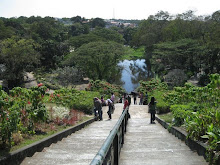Tuesday, July 03, 2012
ILOILO | Miag-ao Church
The Miag-ao Church was built in 1786 by Spanish Augustinian missionaries and was declared as part of the UNESCO World Heritage Site "Baroque Churches of the Philippines" in 1993. On the front facade, which is flanked by two watchtower belfries, one can see the unique blending of Spanish and native influences.
The central feature of the bas-relief facade is a large coconut tree which reaches almost to the apex. While an integral part of the Philippine landscape, the coconut tree is also the subject of lore. According to an old Philippine legend, the coconut tree was the only bequest from a loving mother to her two children, a tree which sustained them for life. On the church's facade the coconut tree appears as the "tree of life" to which St. Christopher carrying the Child Jesus on his shoulder is clinging to. The lesser facades feature the daily life of Miagaowanons during the time. Also depicted are other native flora and fauna, as well as native dress.
The church and its watchtowers were also built to defend the town and its people against raids by the Moros. It therefore has thick walls and, reportedly, secret passages. Indeed stretching along the Iloilo coast are defensive towers, but none that equal the size of the Miag-ao. It is because of this defensive purpose that it is sometimes referred to as the Miag-ao Fortress Church.
Source: Wikipedia
ILOILO | Molo Church
Molo is one of the seven districts of Iloilo City. It was built by Spaniards and was formerly called the Parian (Chinatown) due to its large number of Chinese residents and their business establishments in the area at the time. Its name was later changed to Moro during the frequent arrival of Muslim pirates from Mindanao until it later evolved into Molo. Molo was a town before it was absorbed by Iloilo City during its charter in 1937.
The Gothic Renaissance Church of Molo was used as a watch tower to warn the people if there are any attackers on the shore of Iloilo City. It is a fine coral stone church with Classical and Gothic details. It is also known as the feminist church because of the beautiful female saints lining inside the church.
Sometime during 1896, the site was visited by Jose Rizal, mainly to look at the Biblically inspired artwork (no longer present). It was also used as a haven for civilians during the Second World War; testament to the effects of the war are the bullet holes still present in some of its bells.
The first thing that will strike the visitor to the Molo Church are the imposing spires, which are a bright red in color. As impressive as the exterior, the interior is even more stunning. The trained eye will see that the artistry is a magnificent amalgamation of the Gothic and Romanesque architectural styles. To the casual viewer, it is an awesome view, wherein the various shades of yellow, gold and shades of brown combine to create a resplendent area for prayer and devotion.
A tour of the Molo Church will reveal the glorious altars, fashioned in the Gothic manner, and adorned by elaborate works of art. Also prominently displayed are 16 images of female saintly figures including Saint Anne, the patroness to whom the shrine is dedicated.
The views of the Molo Church are compelling at any time of the day, but it is during the afternoon that the full beauty of the magnificent structure is unveiled. Standing outside the church you can see the soft glow of the rays of the sun as they cast down on the façade. The results are unique and fascinating displays of light and shade.
Source: Wikipedia and http://www.iloiloboard.com/molo-church.php
ILOILO | jaro cathedral
The National Shrine of Our Lady of the Candles informally known as Jaro Cathedral is the cathedral seat for the Roman Catholic Archbishop of Jaro. It is located in district of Jaro in Iloilo City, in the province of Iloilo, on the island of Panay, in the Western Visayas region of the Philippines. It is known as the shrine of Our Lady of the Candles under the original patronage of Saint Elizabeth of Hungary.
The church is the famous Parish of Our Lady of Candles, also known as the Jaro Metropolitan Cathedral, the headquarters of the Archdiocese of Jaro and the site of a miraculous statue of the Virgin Mary, which was canonically crowned by the late Pope John Paul II during his visit in 1982. The image is the only religious icon in the country to have been personally crowned by a Pope.
Jaro Belfry, ruined in a 1948 earthquake, but now restored. One of the few belfries in the country that stands apart from the church.
The bell tower unusually is located across a busy street on the Jaro Plaza. Such construction arrangement is rare in the Philippines. Usually the Churches and their belfries are built adjacent to each other, or at least they are located on the same plot of land. This is a remnant of an older building that collapsed during an earthquake. The original cathedral was built in 1874 by the first bishop of Jaro, Mariano Cuartero, O.P. It was destroyed by an earthquake in January 1948 and later repaired in 1956 by the first Archbishop of Jaro, Jose Maria Cuenco.
Source: http://en.wikipedia.org/wiki/Jaro_Cathedral
Tuesday, November 08, 2011
Vote NOW for PPUR
Only few days left before that judging on November 11, 2001 (that is 11/11/11 to you) and NOW is the time you vote!
Please vote for Palawan Undergroun
Friday, September 30, 2011
HELP for Pedring
From Sidney's blog: Last September 27, 2011 a powerful typhoon (Pedring, international name - Nesat) has struck the Philippines. Witnesses said flooding in parts of Manila was the worst in decades. In the shanty village of Ulingan in Tondo (click here) which is facing the sea, most of the homes were destroyed leaving many families homeless. All those families are already living below the poverty line. Project Pearls and Photo Kalye are organizing relief operations. They need your help more than ever.
Friday, August 26, 2011
traditional filipino folk dance - tinikling
Tinikling - Tinikling is considered the national folkdance with a pair of dancers hopping between two bamboo poles held just above the ground and struck together in time to music. Originated from Leyte Province, this dance is in fact a mimic movement of “tikling birds” hopping over trees, grass stems or over bamboo traps set by farmers. Dancers perform this dance with remarkable grace and speed jumping between bamboo poles.
Thursday, August 25, 2011
traditional filipino folk dance - sayaw sa bangko
Sayaw sa Bangko - ("dance on a bench") is a folk dance from the Pangasinan province of the Philippines. Performers dance on top of a bench that is normally six inches wide.
Wednesday, August 24, 2011
traditional filipino folk dance - pandango sa ilaw
Pandanggo sa Ilaw - The word pandanggo comes from the Spanish dance “fandango”characterized with lively steps and clapping while following a varying ¾ beat. Pandanggo requires excellent balancing skill to maintain the stability of three tinggoy, or oil lamps, placed on head and at the back of each hand. This famous dance of grace and balance originated from Lubang Island, Mindoro.
Tuesday, August 23, 2011
traditional filipino folk dance - binasuan
Binasuan - Originated in Pangasinan Province “meaning with the use of drinking glasses”, this vibrant dance basically shows off balancing skill of the performers. Glasses filled with rice wine are placed on the head and on each hand carefully maneuvered with graceful movements. This dance is common in weddings, fiestas and special occasions.
Monday, August 22, 2011
traditional filipino folk dance
Most Philippine dances were originally patterned after European dances during the Spanish regime. Pandango Sa Ilaw, Cariñosa, Rigodon and Balitao are examples of these dances Filipinos are known for. Aside from these western-influenced dances, ethnic-created dances such as Tinikling made its way to nationwide recognition. Despite its apparent adaptation to western dances, still Filipinos pay tribute to their cultural roots. Every district in the islands has its own folk dance, interpreted attractively in festivals and local shows, which have added to the country’s reputed contribution to world’s illustration of traditional arts.
The following are examples of popular Philippine folk dances :
Binasuan - Binasuan originated in Pangasinan Province “meaning with the use of drinking glasses”, this vibrant dance basically shows off balancing skill of the performers. Glasses filled with rice wine are placed on the head and on each hand carefully maneuvered with graceful movements. This dance is common in weddings, fiestas and special occasions.
Rigodon - Originated from Spain, this dance is commonly performed at formal affairs like inaugural balls where prominent members of the government participate and enjoy.
Pandanggo sa Ilaw - The word pandanggo comes from the Spanish dance “fandango”characterized with lively steps and clapping while following a varying ¾ beat. Pandanggo requires excellent balancing skill to maintain the stability of three tinggoy, or oil lamps, placed on head and at the back of each hand. This famous dance of grace and balance originated from Lubang Island, Mindoro.
Tinikling - Tinnikling is considered the national folkdance with a pair of dancers hopping between two bamboo poles held just above the ground and struck together in time to music. Originated from Leyte Province, this dance is in fact a mimic movement of “tikling birds” hopping over trees, grass stems or over bamboo traps set by farmers. Dancers perform this dance with remarkable grace and speed jumping between bamboo poles.
Maglalatik - Originally performed in Binan, Laguna as a mock-war dance that demonstrates a fight between the Moros and the Christians over the prized latik or coconut meat during the Spanish rule, this dance is also shown to pay tribute to the town’s patron saint, San Isidro Labrador. It has a four-part performance such as the palipasan and the baligtaran showing the intense battle, the paseo and the escaramusa- the reconciliation. Moro dancers wear read trousers while the Christian dancers show up in blue. All dancers are male ; with harnesses of coconut shells attached on their chests, backs, thighs and hips.
Cariñosa - Cariñosa is a word that describes an affectionate, friendly and lovable woman. This dance is performed in flirtatious manner with fans and handkerchiefs to assist the dancers’ hide-and-seek movements.
La Jota Manileña - It is a dance named after the capital city of the Philippines, Manila, where an adaptation of Castilian Jota afloats with the clacking of bamboo castanets played by the dancers themselves. The costume and the graceful movements of the performers noticeably inspired by Spanish Culture.
Source: http://www.camperspoint.com
Subscribe to:
Comments (Atom)















































